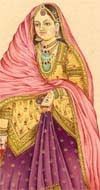
Rani Rudrama Devi (Telugu: రాణి రుద్రమ దేవి) was one of the most prominent rulers of the Kakatiya dynasty on the Deccan Plateau, being one of the few ruling queens in Indian history. She was born, as Rudramba, to King Ganapathideva (or Ganapatideva, or Ganapathi Devudu). As Ganapathideva had no sons, Rudramma was formally designated as a son through the ancient Putrika ceremony and given the male name of Rudradeva. When she was only fourteen years old, Rani Rudramma Devi succeeded her father. Rudramadevi was married to Veerabhadra, Eastern Chalukyan prince of Nidadavolu[1]
Despite initial misgivings by some of her generals who resented a female ruler, she suppressed both uprisings within Kakatiya territory and incursions by neighboring kingdoms with the help of others, most notably Gona Gonna Reddy. An able fighter and dynamic ruler, Rudramba defended the kingdom from the Cholas and the Yadavas, earning their respect. She was one of very few female rulers in south India during her time. Rani Rudramma Devi ruled from 1261 or 1262 until 1295 or 1296.
Among Rani Rudramma Devi's accomplishments during her reign was the completion of Warangal Fort, begun by her father, in the Kakatiya capital of Warangal (one stone hill). Parts of the fort are still standing, including examples of distinctive Kakatiya sculpture. Rudramma Devi remains one of India's most important women.
Legend has it that due to her upbringing as a boy, Rani Rudrama was not much a connoisseur of music and art, but she was quite taken by a form of Shiva Tandavam - Perini which was extinct and it was brought back by Dr. Nataraja Ramakrishna. She found this dance more of an exercise to the soldiers and had it made part of the training of the royal force.


